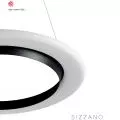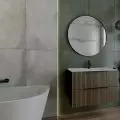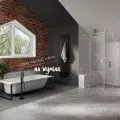Downstairs contemporary, upstairs historical. The designers at Ultra Architects had a daunting task in Poznan's Wilda district. They have just started construction of a complex of buildings that will complement the space of the historic district next to the inner city. It is to be light and restrained, yet non-monotonous.
The unusual gap between two important streets of Wilda in Poznań will be filled by three residential buildings under the somewhat mysterious name Dolna Górna Wilda (investor: OKRE). Each house is to be different, though all maintained in the same restrained spirit. The common denominators are light gray plastered facades, portfenets with glass balustrades, balconies, loggias, rooftop terraces and space for services in the first floors adjacent to the streets. The new buildings will be built on a small slope and an area that today serves as a parking lot in a wedge between Górna Wilda and Dolna Wilda streets.
Residential complex „Dolna Górna Wilda” in Poznań, proj. Ultra Architects—general view
© OKRE, www.dolnagornawilda.pl
Upper Wilda is one of the two main tracts of the district. Rising and picturesquely meandering, it leads towards the Wildeckie market. Lower Wilda, on the other hand, is a straight line between compact buildings and the open space of the so-called southern green wedge along the former Szyc stadium (ultimately, the stadium and the area around it will serve mainly a park function—according to the concept selected in this year's competition).
The intersection of Spadzista and Górna Wilda streets, the wooded area will be developed
photo: Jakub Głaz
will the wait pay off?
The plot on which the houses by Ultra Architects will stand is located very close to the inner city, three hundred meters from the Old Brewery and the pedestrian zone in Półwiejska Street. It's a wonder that such an attractive location has waited until now to be supplemented with development. Many of the neighboring lots have been occupied over the past quarter century by postmodern residential plats. A contemporary hotel with a blocky exterior clad in cheap historicizing detail also stands next door.
Dolna Wilda Street, view toward the center—the space between the houses of the western frontage will be filled with a new building; in the background is a skyscraper at Andersa Square
photo: Jakub Głaz
The delay in investing will thus work out for the site, because the new project to complete the Wilda quarter presents a higher level than its neighbors of recent decades. A guarantee of decent quality is also provided by the experience and numerous successes of the award-winning designers. Incidentally, this is not Ultra Architects' first project in Wilda. The studio has to its credit a residential development on Fabryczna Street, as well as a very successful characteristic residential and commercial building on Wildecki Market 3. This realization (the investor was also OKRE) created a previously non-existent frontage of the historic market square, and the architects were honored for it a year ago in the competition for the Architectural Award of the Wielkopolska Region. They also won an honorable mention in Poznan's J. B. Quadro competition. Now, due to its location, the project is less spectacular and was certainly more difficult to design.
not an easy puzzle
There were several challenges. The first was the neighboring development. At Górna Wilda, the project site is directly adjacent to a tenement house from the early 20th century. There are similar buildings nearby, and there are also simpler houses from the interwar period verging on modernism. Almost opposite, attention is drawn to a sizable neo-modernist corner block from less than a decade ago. The Lower Wilda frontage, on the other hand, includes the aforementioned hotel and postmodern plomba, as well as the open space around the former Szyc Stadium. The second challenge was the slope of the site, its irregular shape and the strong exposure of a section of the plot on the curve of Górna Wilda Street. The third difficulty? With a high degree of certainty, we can deduce that it was to meet the investor's expectations regarding the intensity of development and cost.
The site of the „Dolna górna Wilda” investment—view from Górna Wilda Street towards Dolna Wilda Street and further—towards the stadium; on the left—the Włoski Hotel
photo: Jakub Glaz
So what will the new residential complex look like? It will present itself most interestingly from the „historical” side. At Górna Wilda, the building is adjacent to an over 100-year-old tenement, referring to it in form and division of the facade—but in a contemporary way—without imitation or pastiche. On the other hand, the plot is adjacent to an undeveloped area, but the design does not show (as one would expect in a frontage development) a blind wall waiting for the construction of another tenement house. Instead, we can see an interestingly sculpted northern elevation at the prescribed distance from the plot boundary.
Residential complex „Dolna Górna Wilda” in Poznań, designed by Ultra Architects, visualization—Górna Wilda street, view from the outlet of Spadzista street, on the left you can see the corner of the front and north elevation
© Ultra Architects / OKRE
The designers explain that this is the result of an unfortunate modification of regulations more than four years ago. From now on—when there is no local plan allowing it (and there is none here)—it is not possible to create a compact street frontage (reaching the boundary of the plot) unless a building with a blind wall already stands on the neighboring one. The northern elevation, at the height of the slight curve of the street, will therefore interestingly close the view axis from the center (until the neighbor puts up his plat).
no micropathology
Along Lower Wilda it will be much quieter. The lower building will closely complement the frontage between the hotel and the postmodern infill. Simple, very economical facades enlivened by an alternating rhythm of windows will connect the two disparate buildings in the right way.
„Dolna Górna Wilda” residential complex in Poznań, proj. Ultra Architects, visualization—the eastern elevation of the lower building will complement the frontage of Dolna Wilda Street.
© Ultra Architects / OKRE
Almost equally restrained will be the elevations of the third, middle building, adjacent to the existing house next door in the second row of the development. At the same time, it's hard not to notice that the middle building could be a bit less bulky, and the carefully planned green spaces(with a „mosaic arrangement” of vegetation) between the new houses—larger. The developer's calculations probably did not favor such a solution.
Residential complex „Dolna Górna Wilda” in Poznań, proj. Ultra Architects, visualization—view from the project area towards Górna Wilda St.
© Ultra Architects / OKRE
So it will be quite dense, but—fortunately—the complex is not threatened by too many tenants. Only 93 apartments are to be built here. In the upper and middle buildings, the units will be spacious, three- or four-room units—with areas ranging from about 60 to about 110 sqm. Only in the lower plomb are smaller meters to prevail: from 33 sqm upwards. There will also be no scourge in the form of "service" micro-apartments. Places for cars will be located in a single-level garage hall.
„Dolna Górna Wilda” residential complex in Poznań, proj. Ultra Architects, visualization—east elevation of the lower building along Dolna Wilda Street.
© Ultra Architects / OKRE
It's just a pity that—even despite the large square meters—the apartments lack separable kitchen annexes with an independent window, and some of the units have one-sided lighting. This handicap weakens the generally good rating of the projections and is derived from corridor-like layouts of internal communication. One that can be served by a single elevator and staircase (again, investor frugality, typical, by the way, of almost all developers today).
Zięta will sweeten everything for you
These drawbacks will perhaps be sweetened for residents by added value in the form of the investor's announced
striking compositions in the lobby and apartment signage designed by Oskar Zięta, made of [...] polished steel processed in FiDU technology [...]. In turn, at the highest point of the establishment, on the side of Górna Wilda Street, the location of Zięta's urban sculpture is planned, which will be visible to street passersby.
Górna Wilda Street, view toward the center, in place of the trees one of the buildings of the new project will be built
photo: Jakub Głaz
New trees are to be planted next to the sculpture, to replace the specimens that will have to be cut down for construction. Compensatory plantings are also planned for the nearby John Paul II Park. When will we be able to compare visualizations and announcements with implementation? Work is expected to start this fall. The date of the end of the works is not given by the investor.




















































